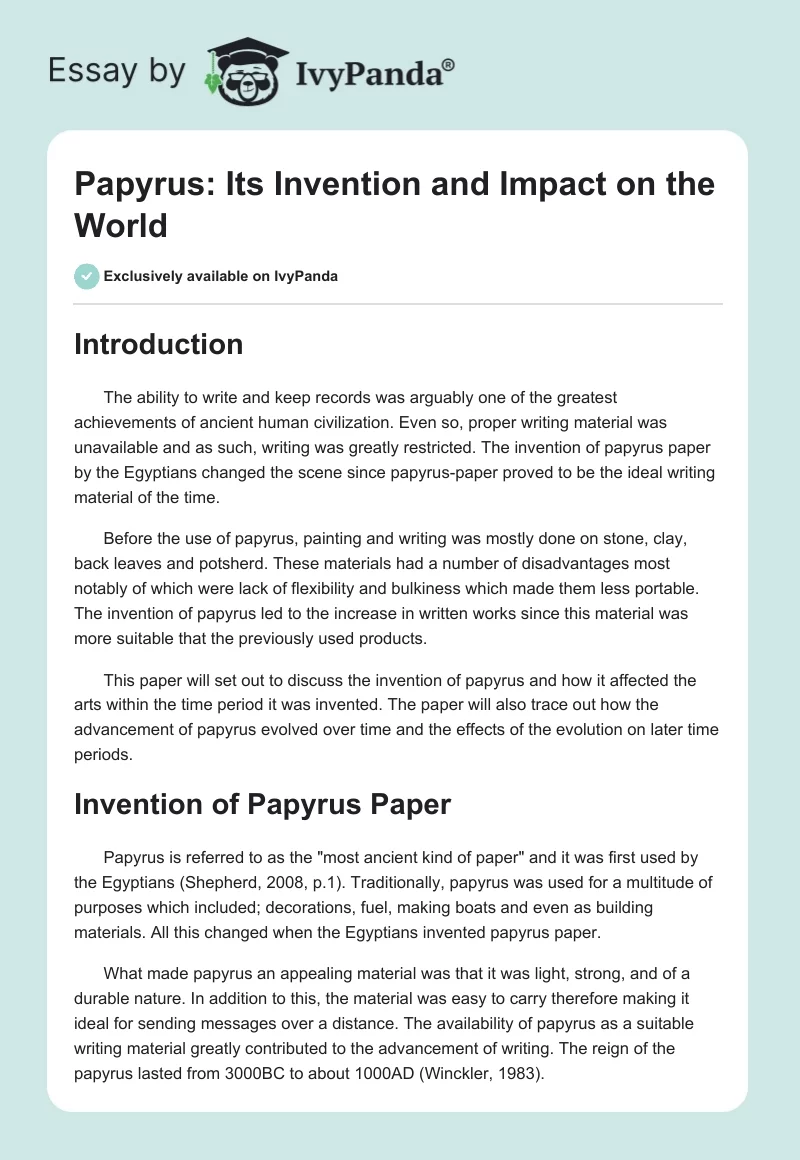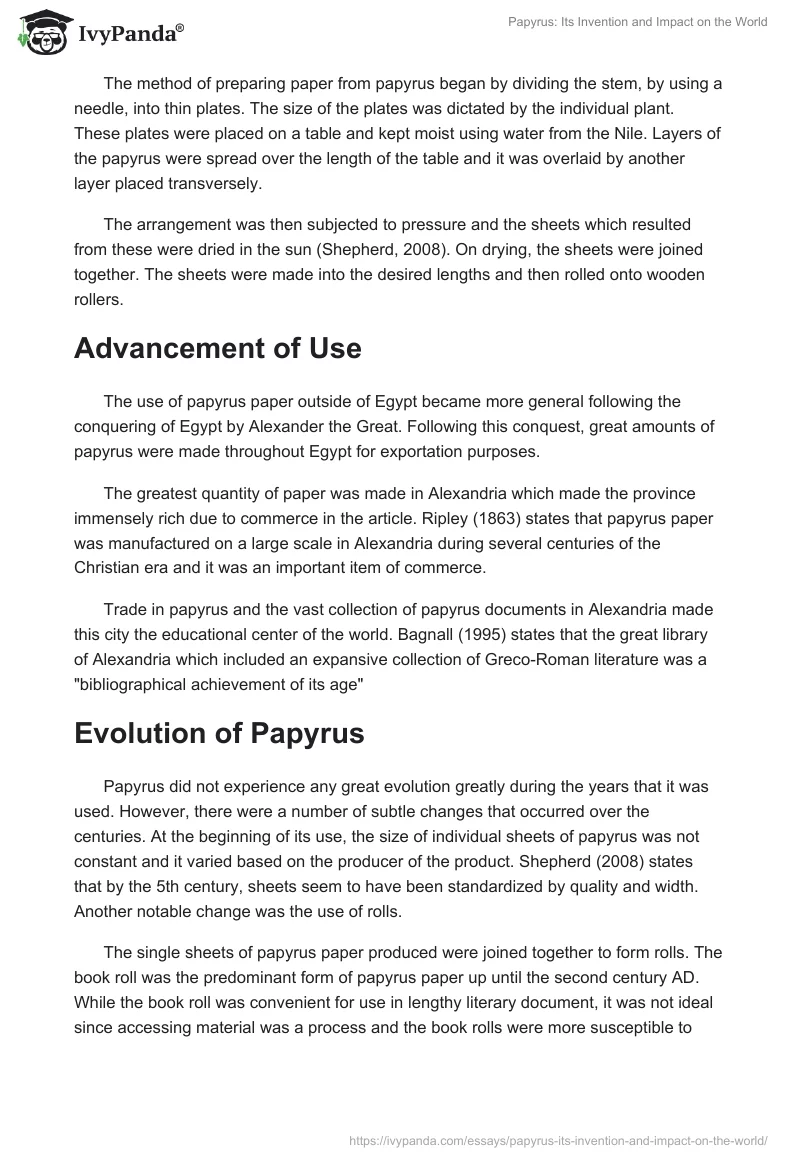Introduction
The ability to write and keep records was arguably one of the greatest achievements of ancient human civilization. Even so, proper writing material was unavailable and as such, writing was greatly restricted. The invention of papyrus paper by the Egyptians changed the scene since papyrus-paper proved to be the ideal writing material of the time.
Before the use of papyrus, painting and writing was mostly done on stone, clay, back leaves and potsherd. These materials had a number of disadvantages most notably of which were lack of flexibility and bulkiness which made them less portable. The invention of papyrus led to the increase in written works since this material was more suitable that the previously used products.
This paper will set out to discuss the invention of papyrus and how it affected the arts within the time period it was invented. The paper will also trace out how the advancement of papyrus evolved over time and the effects of the evolution on later time periods.
Invention of Papyrus Paper
Papyrus is referred to as the “most ancient kind of paper” and it was first used by the Egyptians (Shepherd, 2008, p.1). Traditionally, papyrus was used for a multitude of purposes which included; decorations, fuel, making boats and even as building materials. All this changed when the Egyptians invented papyrus paper.
What made papyrus an appealing material was that it was light, strong, and of a durable nature. In addition to this, the material was easy to carry therefore making it ideal for sending messages over a distance. The availability of papyrus as a suitable writing material greatly contributed to the advancement of writing. The reign of the papyrus lasted from 3000BC to about 1000AD (Winckler, 1983).
The method of preparing paper from papyrus began by dividing the stem, by using a needle, into thin plates. The size of the plates was dictated by the individual plant. These plates were placed on a table and kept moist using water from the Nile. Layers of the papyrus were spread over the length of the table and it was overlaid by another layer placed transversely.
The arrangement was then subjected to pressure and the sheets which resulted from these were dried in the sun (Shepherd, 2008). On drying, the sheets were joined together. The sheets were made into the desired lengths and then rolled onto wooden rollers.
Advancement of Use
The use of papyrus paper outside of Egypt became more general following the conquering of Egypt by Alexander the Great. Following this conquest, great amounts of papyrus were made throughout Egypt for exportation purposes.
The greatest quantity of paper was made in Alexandria which made the province immensely rich due to commerce in the article. Ripley (1863) states that papyrus paper was manufactured on a large scale in Alexandria during several centuries of the Christian era and it was an important item of commerce.
Trade in papyrus and the vast collection of papyrus documents in Alexandria made this city the educational center of the world. Bagnall (1995) states that the great library of Alexandria which included an expansive collection of Greco-Roman literature was a “bibliographical achievement of its age”
Evolution of Papyrus
Papyrus did not experience any great evolution greatly during the years that it was used. However, there were a number of subtle changes that occurred over the centuries. At the beginning of its use, the size of individual sheets of papyrus was not constant and it varied based on the producer of the product. Shepherd (2008) states that by the 5th century, sheets seem to have been standardized by quality and width. Another notable change was the use of rolls.
The single sheets of papyrus paper produced were joined together to form rolls. The book roll was the predominant form of papyrus paper up until the second century AD. While the book roll was convenient for use in lengthy literary document, it was not ideal since accessing material was a process and the book rolls were more susceptible to tear. The introduction of the papyrus codex or book proved to be revolutionary as the codex was more convenient and hence preferred over the roll.
Another change in papyrus was in its pricing. At the onset, the product was modestly priced and could be afforded my most middle class people. However, the pricing of papyrus was made very expensive possible because of high taxation imposed by the Egyptians who had a monopoly on the product.
Bevan (2001) reinforces this supposition by revealing that papyrus paper in Egypt was a monopoly of the crown and the product could only be procured from the workshops of the king of Egypt. The various other uses of papyrus were forbidden and by the Sixth century, the plant had been monopolized by the government (Ripley, 1863).
Effects of the Papyrus
The impact of papyrus throughout the world is undeniable. Bevan (2001) reveals that the English word “Paper” is in fact derived from the Egyptian word “papyrus” which meant “that which belongs to the house”. The invention of paper changed the Egyptians perception of papyrus. From that period henceforth, Egyptians held the papyrus and the scribes who wrote on them in very high esteem.
An extract from a 19th-dynasty praise of scribes states that “more excellent is a papyrus roll than a built house, than a chapel in the west” (Mieroop, 2010, p.97).
Papyrus led to the increase in book production throughout Greece. Bevan (2001) states that books were an extremely rare possession in the Greek world before the introduction of the papyrus material towards the end of the seventh century B.C. Before they obtained the papyrus from the Egyptians, the Greek had written on skins, wooden tables and other hard material that could be written on.
This lack of proper writing material made Greek writings scarce and, when available, very expensive.
The Egyptians began to export their papyrus to Greek in the seventh century. This gave the Greek a more convenient writing material than they had even had before. As a consequence of this, Greek books began to multiply and increase in accessibility.
Advancements’ Connection to the Humanities
Papyrus gave people a new way to record their history. Winckler (1983) states that prior to the invention of papyrus, Egyptians recorded their history by covering with inscriptions the stone walls of their building. Records of king’s exploits and their campaigns were therefore presented in walls and ceilings of temples and palaces.
Nicholson and Shaw (2000) reveal that a vast majority of the papyrus documents were written in Greek as a result of the great influence of the Roman Empire. Even so, some were written by the Egyptians in various native languages. There are many types of documents that are found written on papyrus. Literary which make up a small percentage of these documents add to our knowledge of ancient traditions of the Egyptians and the Greek.
The vast majority of written documents are categorized as “documentary texts” and they range from; letters, marriage contracts, administrative records, government decrees, and daily journals by civil servants (Bagnall, 1995).
The Historical Egyptian papyri have thrown much light on the history of Egypt and are used by many historians as the primary source material when studying Egyptian history.
Papyrus was used to chronicle judicial and civil affairs as well as some of the manners and customers of the people (Ripley, 1863). The greatest record of religious history of Lower Egypt is found in 150 papyri which were discovered by M. Mariette.
The historical significance of papyrus is as a result of its ability to resist the effects of time. While documents made from papyrus paper were available in many regions of the world, the ones that survived up to the present time are found almost exclusively in Egypt. Shepherd (2008) attributes the survival of papyrus documents for up to a thousand years to the dry desert environment of Egypt.
Early biblical texts were written on papyrus. Bagnall (1995) reveals that biblical literature was written on papyrus and it was copies of the same that were later on written on parchment. Classical Greek authors also made use of papyrus to write their works. These use of papyri for classical has resulted in a great gain to literature. Early works of Euripides, Homer, Plato, Demosthenes and Isocrates written on papyrus rolls were discovered in 1891.
Decline of Papyrus
Papyrus was an expensive product and Mieroop (2010) illustrates that people regularly reused rolls, writing on the reverse and in spaces left blank in the midst of a text. As such, the introduction of cheaper and convenient writing material led to the decline in the use of papyrus.
Two materials in particular led to the eventual decline of papyrus use; Parchment and rag paper. Parchment which was developed by the Arabs had an advantage over papyrus since it could be manufactured in many regions of the world unlike papyrus whose production was restricted to Egypt.
In addition, parchment was easier to bind into codex than papyrus. Rag paper was invented by the Chinese and the technology was brought from the Far East by Arabian traders during between the seventh and eight centuries. As such, the eighth century saw the decline in the use of the expensive papyrus as cotton paper began to rise in popularity. By the twelfth century, papyrus had entirely disappeared, replaced by parchment and vellum.
Conclusion
This paper will set out to discuss the invention of papyrus and how it affected the arts within the time period it was invented. The paper has revealed that papyrus was the first writing paper and it was invented in Egypt. The evolution of papyrus from its original single sheet form to its later codex format has also been documented.
Papyrus played a great roll in humanities since it enabled books and documents to be produced on a previously unprecedented scale. During the millenniums reign of the papyrus, it was one of the most important articles of trade for Egypt. The paper has concluded by stating the role of the Chinese rag paper invention in the demise of papyrus as the ideal writing material.
References
Bagnall, Roger S. 1995. Reading Papyri, Writing Ancient History. New York: Routledge.
Bevan, E. (2001). Alexandrine Literature and Learning. Mittal Publications.
Mieroop, D.M. (2010). A History of Ancient Egypt. John Wiley and Sons.
Nicholson, P.T. & Shaw, I. (2000). Ancient Egyptian Materials and Technology. Cambridge University Press.
Ripley, G. (1863). The New American Cyclopaedia: A popular Dictionary of general Knowledge. D. Appleton and Company.
Shepherd, W. H. (2008). “The Preservation and Conservation of Papyri”. MLIS 7710 Archival Theory and Issues.
Winckler, P.A. (1983). Reader in the History of Books and Printing. Greenwood Publishing Group.


